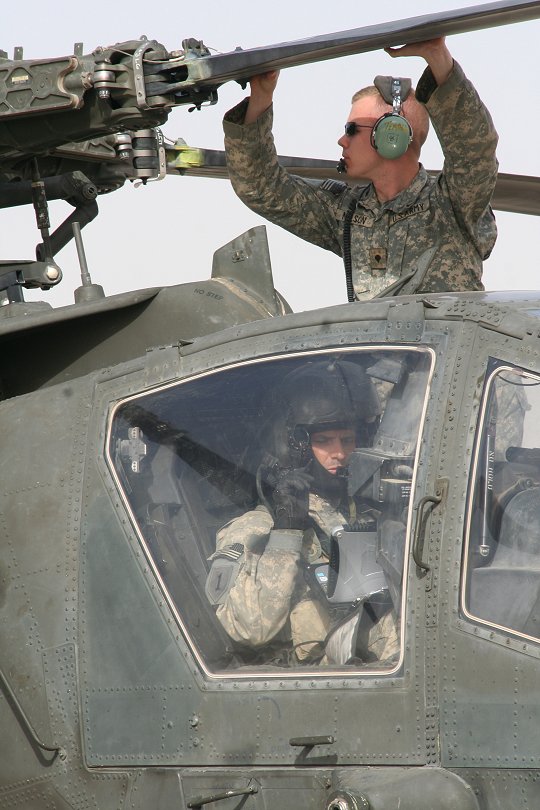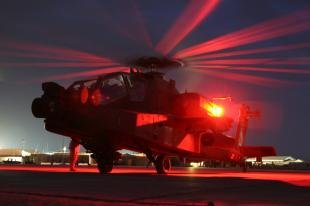« SHUT up McCain Greenjeans Since You Won't Drill in ANWAR! | Main | Chief Warrant Officer Fought Hard For Chance To Go To Iraq »
June 12, 2008
Gunfighters Taking Flight

Spc. Theodore Nelson, (top) AH-64D Apache Longbow crew chief from Company C, 1st Attack Reconnaissance Battalion, 1st Aviation Regiment, conducts final pre-flight checks with Chief Warrant Officer 3 Philip Mann, pilot Co. C on May 26. The 1-1 ARB Gunfighter air and ground crews work around the clock sustaining air operations and are part of the Combat Aviation Brigade, 1st Infantry Division, from Fort Riley, Kan., flying in support of Task Force Iron, 1st Armored Division, in northern Iraq.

Gunfighters Take Flight
By Maj. Enrique T. Vasquez
Combat Aviation Brigade, 1st Infantry Division Public Affairs Office
TIKRIT, Iraq
Since the days of early aviation, Army pilots have played a key role in the outcome of ground battles and air missions. For pilots flying the AH-64 Apache Longbows of the 1st Attack Reconnaissance Battalion, 1st Aviation Regiment in northern Iraq the legacy of influencing the fight continues through careful mission preparation and teamwork. These pilots known as the Gunfighters are part of the Combat Aviation Brigade, 1st Infantry Division’s efforts to sustain a constant presence over the skies of northern Iraq in support of Task Force Iron.
However, before the Gunfighters jump into their cockpits and head-out into the skies of Multi-National Division-North they must plan meticulously prior to each mission.
“Pilots are briefed on the five Ws- who, what, where, when and why- in respect to the operations portion of the brief. The crews receive instructions on what the ground commanders want along with any changes in procedures or radio frequencies,” said 1st Lt. Peter Huang, a battle captain for 1-1 ARB.
“Furthermore, pilots receive any changes in battlespace and any updates as to what friendly forces are in the area of operations.”
Just as the operations officer gives a detailed briefing so does the intelligence officer. Everything the enemy might be doing or trying to do is briefed to include the careful articulation of possible enemy courses of action.
“We find patterns and trends the enemy might be engaged in like IED, small arms fire and emplacements. We give the pilots an assessment so they know what to look for, how the enemy might act and what to expect,” said Staff Sgt. Floyd Perry, 1-1 ARB intelligence analyst.
Although the Apache is a two-seater helicopter, both pilots in an AH-64 Apache Longbow has a certain job to perform. While both are capable of flying the aircraft, the duties of the command pilot and the co-pilot gunner called the CPG; are distinctly different in a combat situation.
“The pilot, maneuvers the helicopter so that the CPG can fire,” said Lindeman.
“The advantage to being the CPG is that you have laser and you can shoot missiles or the 30mm cannon.”
“There is nothing better than catching someone emplacing IED. The ground units are always appreciative of us being there.”
There are several types of missions Apache crews often fly. The missions vary between counter IED reconnaissance, to ground support.
Apache pilots say they can see the positive contributions they are making in defeating insurgents.
“The violence has scaled down quite a bit since we got here,” said Menold.
“We used to catch a lot of insurgents emplacing IEDs. However, there are not as many emplacers as there used to be. We are definitely having an impact on IED activity,” said Menold.

Wild Thing's comment........
More good news about our awesome troops, news that puts the media and the left in such a bad mood. heh heh
God bless our troops!!!!!
Posted by Wild Thing at June 12, 2008 02:45 AM
Comments
The Apache is quite a flying machine. It takes a lot of skill to fly one. The high tech avionics and weapons make it at awesome weapon. Being able to fly, hunt and shoot at night are priceless advantages.
Posted by: TomR at June 12, 2008 09:51 AM
Tom, it is beautiful. heh heh I love things like this.
Posted by: Wild Thing at June 12, 2008 05:20 PM
